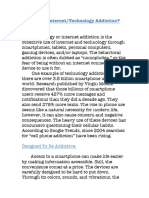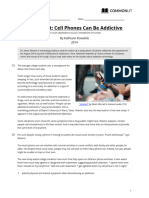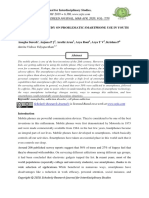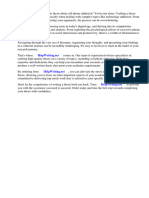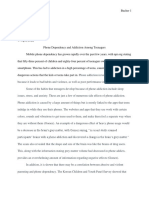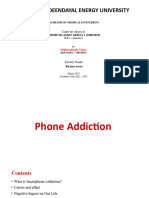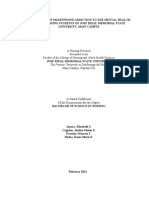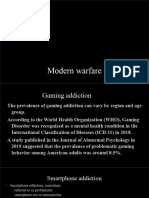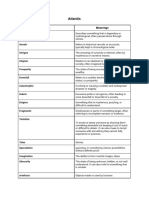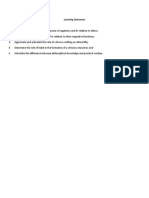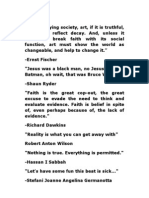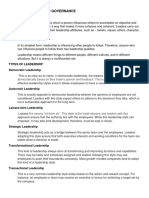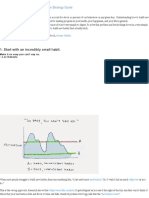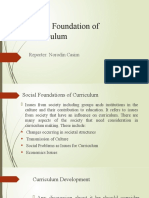EFFECTS
World Health Organization found out that women were more likely to have depression, anxiety, and
higher smartphone use, including spending more time on their phones and making more calls. People
with higher smartphone addiction scores were more likely to feel depressed or anxious, own their
phone longer, and spend more time on calls. These scores were especially high among final-year
students, single students, and those using their phones for more than 4 hours a day. (Dalia El-Sayed
Desouky and Hany Abu-Zaid, 2020)
CONSEQUENCES
NIH also discovered that mobile addiction not only has physical effects but also psychological and
academics effect at the same time. Sleep deficit, anxiety, stress, and depression which are all
associated with internet abuse, have been related to mobile phone usage too (De-Sola Gutiérrez et
al., 2016). A randomized sample of 100 students was collected. The survey showed that there were
negative psychological effects of smartphone usage on the young generation. They felt depressed
and anxious while using cell phones. On the other hand, some youngsters showed relax behaviour
even without having a cell phone. A study by Kimberely G. Tuco et al. in the January 2023 issue of
Healthcare Informatics Research, learned that the overall prevalence of nomophobia (fear of living
without a mobile phone) in universities is nearly 100% in which 24% is mild, 56% is moderate and
17% is severe.
EVALUATION OF PERSPECTIVES
Phone addiction is a global problem influencing many countries in the world. China, Bangladesh and
USA all have phone addiction. All the three countries have at least 35% phone addiction rate. USA
has the least phone addiction with 37% followed by India with almost 39% to 44% and then China with
46.3%. Bangladesh has the most with 61.4%. Although the world is seemed to be having around
84% phone addiction. Two of the countries China and USA have been working on phone addiction
with China limiting the children to 2 hours screen time and USA are decreasing the number of phone
sells per year.
KEY SOLUTION
Phone Addiction can be very dangerous but it can be controlled. Clearfork Academy has given many
ways to reduce phone addiction including setting parental control of 1-2 hours a day, restrict phones
on dining tables, buy them a normal phone not smart phones if possible and making them do a lot of
co-curricular activities such as sports, music or art. Another way of reducing phone addiction is by
deleting the apps you don’t need such as Games and social media. In addition, parents can also set
individual app timers.
EVALUATION OF SOURCES
Sources such as NIH, Pew Research Center, CNN, Stastista, WHO and The Diamond Luxury Rehab
have been very helpful with real statistics, and good referencing where as some sources don’t have
good reference, no author nor date of publishment. These sources were not biast and had true
information. Phone addiction is a very disastrous problem and sources like NIH are trying to solve it
while others are making it worse, spreading wrong information.
CONCLUSION
This essay was an epiphany for me as I used to think that phone addiction is mild as having 4-5 hours
is not phone addiction but I know now that even 4 hours is mild phone addiction. Phones have many
advantages as shown but only if you use it correctly. People worldwide need to really take this
seriously or else in the next few years the number of deaths could increase. I have learned a lot
during this essay and I will always control my screen time.
�WORD COUNT: 994
REFERENCES:
Sehar Shoukat, Published Online 2019 Feb 4, Cell phone addiction and psychological health in
addictions, https://www.ncbi.nlm.nih.gov/pmc/articles/PMC6449671/#R10. (Accessed on 28/09/2024)
Ahmed Zayed, MD, Latest Edited on 04/26/2024, Phone Addiction: definition, symptoms, risk factors,
and treatment, https://diamondrehabthailand.com/what-is-phone-addiction/. (Accesed 29/09/2024)
Kelly Wallance, Updated on Fri July 29,2016, Half of teens think they’re addicted to their
smartphones, https://edition.cnn.com/2016/05/03/health/teens-cell-phone-addiction-parents/
index.html. (Accessed 27/09/2024)
Federica Laricchia, Published on Aug 31, 2023, Number of smartphone unit shipments in the United
States from 2013 to 2027, https://www.statista.com/statistics/619811/smartphone-unit-shipments-in-
the-us/#:~:text=In%20the%20United%20States%2C%20smartphone,to%20106%20million%20by
%202027. ( Accessed on 28/09/2024)
Zubair Ahmed Ratan, Anne-Maree Parrish, Mohammad Saud Alotaibi, and Hassan Hosseinzadeh,
published online 2022 Dec 9 Prevalence of Smartphone Addiction and Its Association with
Sociodemographic, Physical and Mental Well-Being: A Cross-Sectional Study among the Young Adults
of Bangladesh, https://www.ncbi.nlm.nih.gov/pmc/articles/PMC9778917/. (Accessed 28/09/2024)
Austin Davis, Christine Zambos, June 18,2024, Understanding Teen Phone Addiction,
https://clearforkacademy.com/blog/teen-phone-addiction/#:~:text=Teen%20Phone%20Addiction
%20By%20the%20Numbers&text=One%20US%20study%20found%2083,hours%20spent%20on
%20screen%20time. ( Accessed on 29/09/2024)
Mary Madden and Amanda Lenhart, November 16, 2009, Teens and Distracted Driving: Major
Findings, https://www.pewresearch.org/internet/2009/11/16/teens-and-distracted-driving-major-
findings/. (Accessed on 28/09/2024)
Merissa A. Yellman, MPH; Leah Bryan, MPH2; Erin K. Sauber-Schatz, PhD; Nancy Brener, PhD,
August 21, 2020, Transportation Risk Behaviours Among High School Students — Youth Risk
Behaviour Survey, United States, 2019, https://www.cdc.gov/mmwr/volumes/69/su/su6901a9.htm.
(Accessed on 29/09/2024)
Dalia El-Sayed Desouky and Hany Abu-Zaid, 17 February, 2019, Mobile phone use pattern and
addiction in relation to depression and anxiety, https://www.emro.who.int/emhj-volume-26-
2020/volume-26-issue-6/mobile-phone-use-pattern-and-addiction-in-relation-to-depression-and-
anxiety.html (accessed 08/01/2025)
�Sehar Shoukat, 4 February, 2019, Cell phone addiction and physiological health in adolescents,
https://pmc.ncbi.nlm.nih.gov/articles/PMC6449671/#R9 (accessed 09/01/2025)



